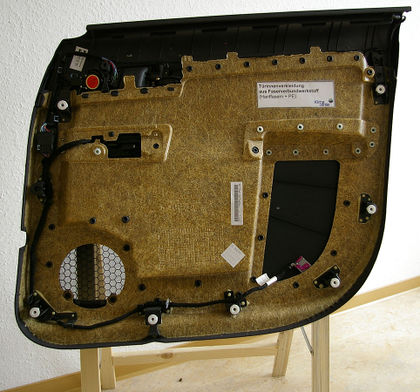Biocomposite: Difference between revisions
Jump to navigation
Jump to search

(Created page with "thumb|upright=1.4|Interior carpeting of a car's door made by a biocomposite of [[hemp fibres and polyethylene]] A biocom...") |
(internal links inserted) |
||
| Line 11: | Line 11: | ||
* Most widely used: Flax, Jute, [[Hemp]] (see: [[hempcrete]]), Kenaf, Sisal and Coir. | * Most widely used: Flax, Jute, [[Hemp]] (see: [[hempcrete]]), Kenaf, Sisal and Coir. | ||
* Many polymers, such as polyethylene (PE), polypropylene (PP), and polyvinyl chloride (PVC) are being used in wood composites industries. | * Many polymers, such as polyethylene (PE), polypropylene (PP), and polyvinyl chloride (PVC) are being used in wood composites industries. | ||
==OSE Wiki Links== | |||
* [[Composite materials]] | |||
* [[Car/Research Development]] | |||
* [[Basalt Fibers]] | |||
* [[Ferrocement]] | |||
==External Links== | ==External Links== | ||
Revision as of 20:14, 23 July 2016

Interior carpeting of a car's door made by a biocomposite of hemp fibres and polyethylene
A biocomposite is a composite material of resin plus reinforcement with natural fibers (example: hemp fibres and polyethylene). The earliest composite materials were straw and mud combined to form bricks for building construction.
Green Composites: natural fibers with biodegradable resins.
Hybrid Composites: different types of fibers (synthetic, biological) combined into a single matrix.
Examples
- Examples of natural fibers: straw fibers, bast, leaf, seed or fruit, and grass fibers.
- Most widely used: Flax, Jute, Hemp (see: hempcrete), Kenaf, Sisal and Coir.
- Many polymers, such as polyethylene (PE), polypropylene (PP), and polyvinyl chloride (PVC) are being used in wood composites industries.
OSE Wiki Links
External Links
- Wikipedia: Biocomposite and Composite material
- Wikipedia: Cement-bonded wood fiber